Six Months After the LA Fires, California Continues Unprecedented Recovery Campaign
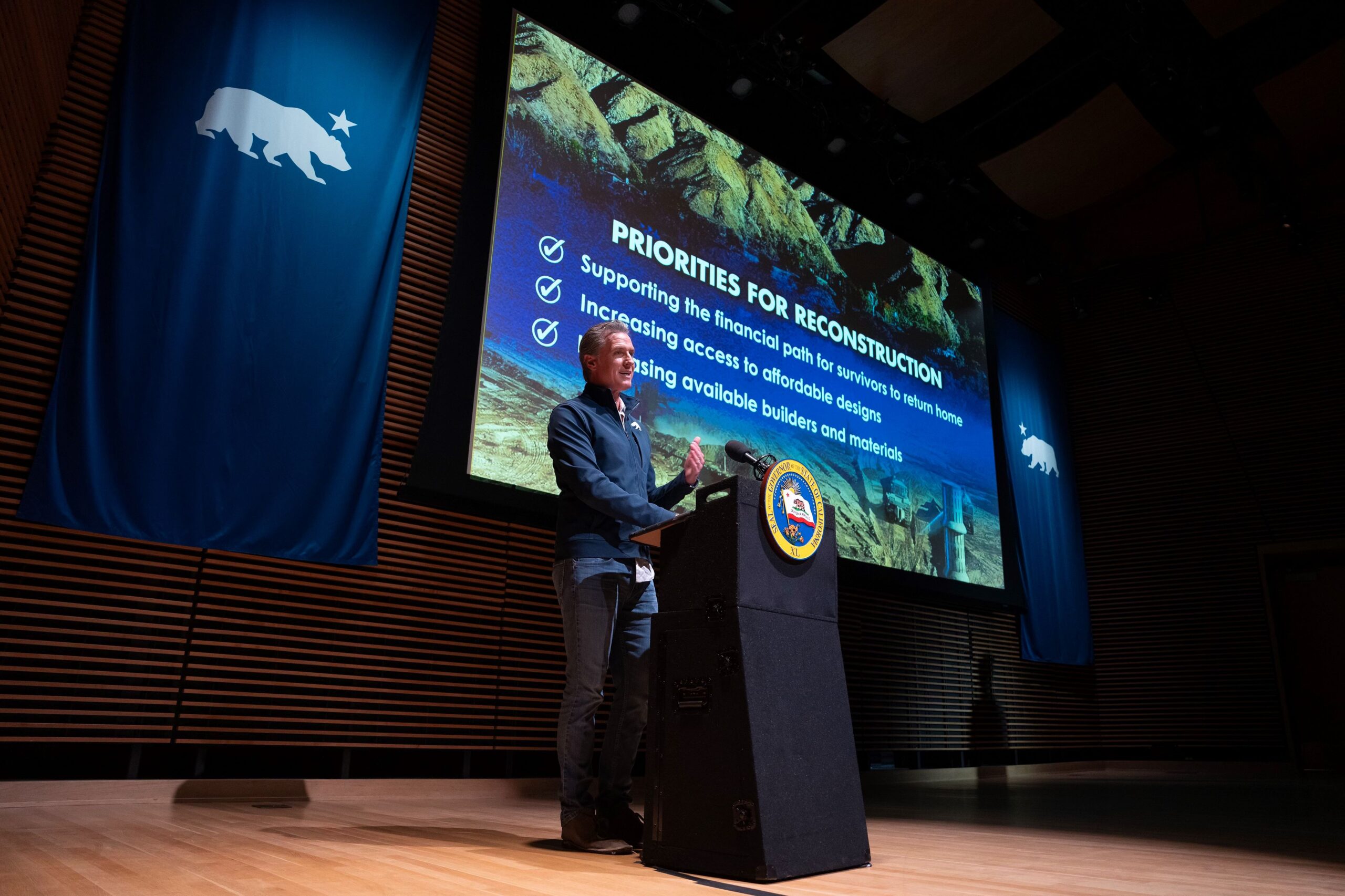
Six Months After the LA Fires, California Continues Unprecedented Recovery Campaign
July 7, 2025 – On the six month anniversary of the Eaton and Palisades fires, Governor Newsom announced the substantial completion of the public debris removal program from more than 10,000 fire damaged parcels. The near-completion of the public debris removal program comes months ahead of schedule. The LA Fires cleanup is the second largest in state history after the Camp Fire and was jointly managed by the Governor’s Office of Emergency Services (Cal OES) and United States Army Corps of Engineers, in partnership with Federal Emergency Management Agency (FEMA), as well Los Angeles County and City of Los Angeles. Of the 12,048 total properties destroyed in the twin fires, 9,873 opted to participate in the cost-free public cleanup program.
Following cleanup, the Governor signed Executive Order N-29-25 to accelerate rebuilding homes and schools impacted by the fires by suspending local permitting laws and building codes. To further spur rebuilding the Governor and the California Department of Housing and Community Development announced the release of $101 million to help rapidly rebuild critically needed, affordable multifamily rental housing in the fire-devastated LA region.
CAL FIRE Releases Vegetation Burn Severity Online Viewer
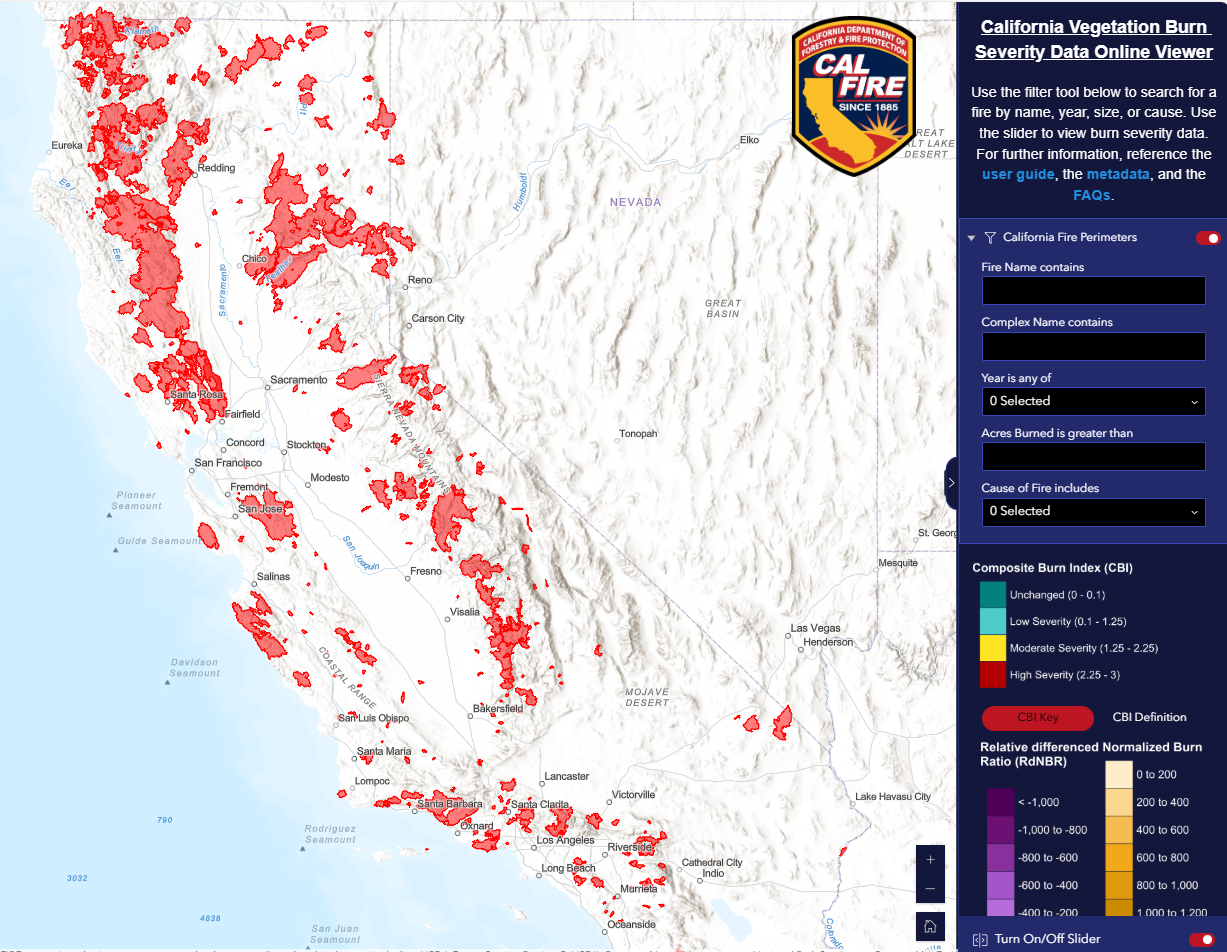
CAL FIRE Releases Vegetation Burn Severity Online Viewer
July 15, 2025 – CAL FIRE’s Fire and Resource Assessment Program (FRAP) released the California Vegetation Burn Severity Online Viewer, a public geospatial tool that displays burn severity data for wildfires across all land ownerships that burned at least 1,000 acres in California from 2015 to 2023. In accordance with Senate Bill 1101, FRAP developed this viewer to enhance public understanding of post-fire conditions and ecological impacts. It offers insight into the severity of impacts to vegetation across both forested and non-forested landscapes. The viewer will support post-fire recovery planning, inform habitat management and conservation efforts, enhance safety through insights for fire suppression planning, and improve preparedness by helping prescribed fire practitioners plan treatments based on past burn severity and fuel changes. Users can view fire perimeters, severity maps, and proportional area statistics for each fire. The viewer will be updated annually to include new fires under 1,000 acres.
California Allocates $9.5 Million for Wildfire County Coordinator Program

California Invests $9.5 Million for Wildfire County Coordinator Program
July 31, 2025 – With the support of Governor Newsom and the California State Legislature, the 2025-26 budget will provide $9.5 million for the Wildfire County Coordinator Program. Delivered in partnership between the California Fire Safe Council and CAL FIRE, the program establishes critical local capacity in 47 California counties with dedicated coordinators to secure funding, implement mitigation projects, engage vulnerable populations, and build resilience in high-risk communities. Coordinators serve as the crucial link between state strategy and local execution—ensuring California communities are better prepared, better connected, and more resilient to wildfire. The program will continue:
- Operationalizing California’s Wildfire and Forest Resilience Action Plan at the county level;
- Accelerating home hardening, defensible space implementation, and public education;
- Standardizing data collection to track local and statewide wildfire resilience progress; and
- Improving public safety, community insurability, and wildfire preparedness in California’s highest-risk regions.
Impact of the Wildfire County Coordinator Program
Investments in community capacity through the program have already produced substantial mitigation and resiliency benefits:
- Secured over $85M in funding for local wildfire mitigation projects;
- Coordinated with over 10,000 organizations to increase collaboration, break down silos, and leverage resources for community mitigation;
- Hosted over 3,800 events for community engagement and education;
- Educated and empowered over 800,000 residents to take action for wildfire resilience; and
- Established more than 100 new FireWise Communities and Fire Safe Councils.
Testimonials from the Wildfire County Coordinators
“The Program has allowed Del Norte County Fire Safe Council to protect many underserved residents and coordinate with other wildfire mitigation groups to maximize impact. Our County Coordinator has brought nearly $4 million in federal funding to Del Norte County, created defensible space around 372 homes, and completed 1,500 home assessments.”
– Aaron Babcock, Del Norte County
“A small investment in capacity can lead to sustainable, long-term improvements for any organization. Because of the County Coordinator Grant, Plumas Fire Safe Council had the capacity to obtain a $6.8 million dollar grant dedicated to hazardous fuels reduction and assessment.”
– Liam Gallaher, Plumas County
“The County Coordinator Grant has supported collaboration in our county by allowing us to create a collaborative meeting of 14 fire prevention agencies in the county to better inform the public and improve our ability to leverage funds and labor.”
– Jon Cottington, Madera County
“We’ve been able to significantly expand our youth education impact by implementing three new school programs and getting back into the classroom with students for the first time since the 2018 Camp Fire.”
– Lauren de Terra, Butte County
“The program has given us the time and opportunity to strengthen our outreach countywide while implementing critical fuel reduction programs. We’ve also been able translate educational materials into Spanish, expanding our outreach to underserved populations.”
– Marika Ramsen, Sonoma County
“We’ve reduced redundancy, supported capacity and collaboration for other Fire Safe Councils, and boosted community engagement through Firewise USA. We also learn from other County Coordinators & implement those lessons learned.”
– Stephen Watson, Ventura County
USFS Invests Nearly $8 Million in Wood Innovation Grants in California
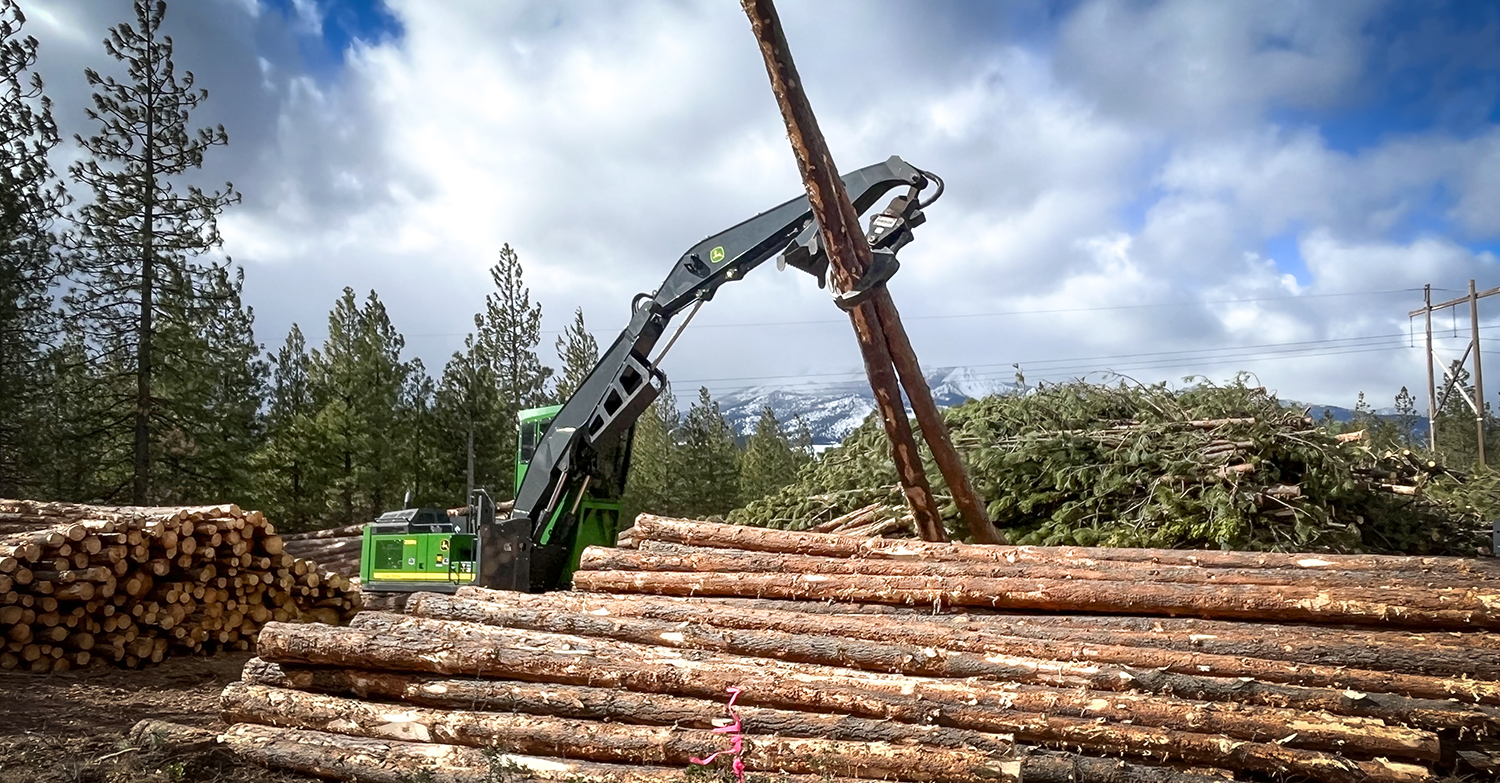
USFS Invests Nearly $8 Million in Wood Innovation Grants in California
July 17, 2025 – The U.S. Forest Service announced awarding $80 million in Wood Innovations and Wood Product Infrastructure Grants to spur wood products manufacturing, expand active forest management, and accelerate energy innovation. Of these investments, nearly $8 million will go to 16 projects in California. A list of California awardees is below:
Wood Product Infrastructure Assistance Grant Program:
- Alpenglow Timber, LLC – $906,492: Establishes sawmill operations to support reduced wildfire risk and active forest management on National Forests and tribal forestlands in California and Nevada.
- California Hotwood, Inc. – $232,000: Upgrades firewood processing capacity to support reduced wildfire risk and active forest management on National Forests in California.
- Fall River Resource Conservation District – $252,642: Upgrades and modernization of biomass power facility operations to support reduced wildfire risk and active forest management on National Forests in California.
- Franklin Logging, Inc. – $907,568: Upgrades to lumber drying operations at sawmill to support reduced wildfire risk and active forest management on National Forests in California.
- Green Diamond Resource Company – $337,500: Establishes a stationary chipping facility to utilize small diameter and low value species in support of wildfire risk reduction and active forest management on National Forests in California.
- Lignum Support, LLC – $1,000,000: Upgrades and expansion of forest residues chipping operations for biomass energy to expand the utilization of forest residues and reduce wildfire risk and support active forest management on National Forests in California.
- Pacific Ultrapower Chinese Station – $960,000: Improves operational efficiencies at biomass power plant to support reduced wildfire risk and active forest management on National Forests in California.
- Tuolumne Biomass, LLC – $999,131: Upgrades small log processing operation to expand markets for small diameter and lower value species and support reduced wildfire risk and active forest management on National Forests in California.
Wood Innovations Grant Program:
- American Wood Fibers, Inc. – $300,000: Installs wood pellet mill to increase low-value wood utilization while supporting active forest management in California.
- DTE Materials Inc. – $300,000: Advances the production of wood concrete aggregates to improve utilization of low-value biomass and support active forest management.
- Enfilade Partners – $300,000: Designs and engineers a mass timber affordable housing project to accelerate the adoption of domestic mass timber thereby increasing active forest management and markets for small-diameter timber.
- Falk Forestry, Inc – $299,664: Establishes sawmill and firewood production to increase timber utilization and active forest management in Northern California.
- Fall River Resource Conservation District – $150,000: Establishes biochar production capabilities to support active forest management and wildfire risk reduction across national forests in California.
- Happy Camp Community Action, Inc. – $300,000: Advances the development of a new wood composite product to improve utilization of low-value biomass and support active forest management.
- Loamist, Co. – $300,000: Identifies locations for new low-value biomass markets to support active forest management and wildfire risk reduction in California.
- Sierra Institute for Community and Environment – $300,000: Installs mass timber manufacturing equipment thereby increasing active forest management across western forests.
First Set of Projects Fast-tracked as Part of Governor’s Emergency Proclamation on Wildfire

CNRA and CalEPA Identify First Set of Fast-tracked Projects as Part of Governor’s Emergency Proclamation on Wildfire
New Streamlined Process:
Governor Newsom issued an Emergency Proclamation (Proclamation) on March 1, 2025, to confront the severe ongoing risk of catastrophic wildfires that threatens public safety across California. The Proclamation authorizes the Secretaries of the California Natural Resources Agency (CNRA) and the California Environmental Protection Agency (CalEPA) to determine which projects are eligible for suspension of certain State of California statutory and regulatory requirements to expedite critical fuels reduction projects, while at the same time protecting public resources and the environment. The Task Force has established a website that includes eligibility criteria, FAQs, and a link to the application to request a determination of eligibility for suspension of relevant State of California statutory and regulatory requirements. The Secretaries also hosted a virtual briefing on the Proclamation and the process.
First Set of Approved Projects:
Just one week after applications opened, CNRA and CalEPA identified a 450-acre collaborative wildfire resilience project in Humboldt County as the first project to be determined eligible for streamlining. Three projects totaling 882 acres have been approved to date, spanning from the northern California coast to Sierra Nevada Mountains and all the way down to San Diego. Each of these projects involve tribes and other partners, natural resource managers and fire districts. Here is an overview of the first set of approved projects.
- The Prosper Ridge Community Wildfire Resilience Project in Humboldt County is the first approved project under the Governor’s emergency proclamation on wildfire. This collaborative state, federal, and tribal project will treat nearly 450 acres with a combination of mechanical thinning, manual treatments, and prescribed fire.
- The Sycuan Wildfire Resiliency Project covers over 240 acres in San Diego County and aims to protect the Sycuan Reservation from wildfire by reducing fire hazard, ensuring defensible space, and providing safe egress with the use of 300 grazing goats.
- Vedanta Hazardous Fuels Reduction Project will reduce wildfire risk, improve forest health and enhance landscape resilience within the WUI, reducing risk of crown fires spans across 190 acres near Lake Tahoe.
These projects are focused on removing flammable dead or dying trees, creating strategic fuel breaks, creating safe egress along roadways, manual and mechanical removal of ladder fuels and beneficial fire use. Approved project location maps and documentation will be made available on the Task Force website.
Wildfire Project Streamlining Requests
Fast-Tracking Critical Fuels Reduction Projects:
Requests to Suspend State Statutes and Regulations
Governor Newsom issued an Emergency Proclamation (Proclamation) on March 1, 2025 to confront the severe ongoing risk of catastrophic wildfires that threatens public safety across California.
The Proclamation authorizes the Secretaries of the California Natural Resources Agency (CNRA) and the California Environmental Protection Agency (CalEPA) to determine which projects are eligible for suspension of certain State of California statutory and regulatory requirements to expedite critical fuels reduction projects, while at the same time protecting public health and the environment.
Eligibility:
A project is eligible to operate under the suspension of state laws if it meets all four of the following requirements:
1. The primary objective of the project is at least one of these activities:
-
- Removal of hazardous, dead, and/or dying trees
- Removal of vegetation for the creation of strategic fuel breaks as identified by approved fire prevention plans, including without limitation, CAL FIRE Unit Fire Plans or Community Wildfire Preparedness Plans
- Removal of vegetation for community defensible space
- Removal of vegetation along roadways, high-ways, and freeways for the creation of safer ingress and egress routes for the public and responders and/or to reduce roadside ignitions
- Removal of vegetation using cultural traditional ecological knowledge for cultural burning and/or prescribed fire treatments for fuels reduction
- Maintenance of previously established fuel breaks or fuels modification projects
2. The request for suspension is submitted in the 2025 calendar year.
3. Work will be performed or supervised by qualified responsible parties, such as Registered Professional Foresters, Certified Rangeland Managers, qualified vegetation management contractors, qualified incident commanders, certified arborists, certified burn bosses and authorized cultural burners.
4. Work will follow Best Management Practices (BMPs) and measures identified in the Statewide Fuels Reduction Environmental Protection Plan (EPP).
As identified above, projects that receive suspension must focus on critical fuels reduction to combat catastrophic fires and promote community safety and resiliency. This includes, but is not limited to, projects identified in CAL FIRE Unit Fire Plans, Community Wildfire Preparedness Plans, and Utility Wildfire Mitigation Plans provided they meet the objectives above.
Statewide Fuels Reduction Environmental Protection Plan (EPP):
View the redlined changes from the May 2025 version
Project Support Resources:
File a Suspension Request:
Approved Project Information:
FAQ's
Given the severe threat of catastrophic wildfire risk, the Newsom Administration is moving to expedite fuel reduction projects that protect public safety and communities. Consistent with Governor Newsom’s March 1 State of Emergency Proclamation (Proclamation) the Secretaries of the California Natural Resources Agency (CNRA) and the California Environmental Protection Agency (CalEPA) are authorized to determine which projects are eligible for suspension of certain state laws and regulations to expedite critical fuels reduction projects, while at the same time protecting public health and the environment.
A project is eligible to operate under the suspension of state laws if it meets all four of the following requirements:
1. The primary objective of the project is at least one of these activities:
-
- Removal of hazardous, dead, and/or dying trees
- Removal of vegetation for the creation of strategic fuel breaks as identified by approved fire prevention plans, including without limitation, CAL FIRE Unit Fire Plans or Community Wildfire Preparedness Plans
- Removal of vegetation for community defensible space
- Removal of vegetation along roadways, high-ways, and freeways for the creation of safer ingress and egress routes for the public and responders and/or to reduce roadside ignitions
- Removal of vegetation using cultural traditional ecological knowledge for cultural burning and/or prescribed fire treatments for fuels reduction
- Maintenance of previously established fuel breaks or fuels modification projects
2. The request for suspension is submitted in the 2025 calendar year.
3. Work will be performed or supervised by qualified responsible parties, such as Registered Professional Foresters, Certified Rangeland Managers, qualified vegetation management contractors, qualified incident commanders, certified arborists, certified burn bosses and authorized cultural burners.
4. Work will follow Best Management Practices (BMPs) and measures identified in the Statewide Fuels Reduction Environmental Protection Plan (EPP).
As identified above, projects that receive suspension must focus on critical fuels reduction to combat catastrophic fires and promote community safety and resiliency. This includes, but is not limited to, projects identified in CAL FIRE Unit Fire Plans, Community Wildfire Preparedness Plans, and Utility Wildfire Mitigation Plans provided they meet the objectives above.
Eligible entities include, but are not limited to, public agencies, Tribes, Resource Conservation Districts, non-governmental organizations, Fire Safe Councils, utilities and professional land managers.
The following state statutes and regulations that fall within the jurisdiction of the California Environmental Protection Agency and the California Natural Resources Agency are eligible for suspension under the State of Emergency proclamation:
-
-
- California Environmental Quality Act (Public Resources Code [PRC] Section 21000 et seq.)
- California Coastal Act (PRC Section 30000 et seq.)
- California Endangered Species Act (Fish and Game Code [FGC] Sections 2050-2115.5); Prohibition of the take of any species of wildlife designated as endangered, threatened, or candidates for listing.
- Lake or Streambed Alteration Agreement, notification of significant alteration to stream channel, bank or bed (FGC Section 1600 et seq.)
- Native Plant Protection Act (FGC Section 1900 et seq.)
- Western Joshua Tree Conservation Act (FGC Section 1927 et seq.)
- California Fully Protected Birds (FGC Section 3511)
- California Migratory Bird Protection Act (FGC Section 3513)
- California Fully Protected Mammals (FGC Section 4700)
- California Fully Protected Reptiles and Amphibians (FGC Section 5050)
- California Fully Protected Fish (FGC Section 5515)
- FGC Sections 5650 and 5652; Deposition of deleterious material into waters of the state.
- FGC Section 5901; Fish passage.
- FGC Section 5937; Sufficient water for fish.
- FGC Section 5948; Obstruction of streams.
- FGC Section 2000; Taking is unlawful except as provided
- FGC Sections 3503 and 3503.5; Protection for bird nests and eggs and birds of prey
- FGC Section § 86, where “Take” shall be avoided. Take is defined as to hunt, pursue, catch, capture, or kill, or attempt to hunt, pursue, catch, capture, or kill.
- 14 CCR Section 13001 et seq.; California Coastal Commission Administrative Regulations
- California Water Code (CWC) Section 13160 and all regulations pursuant to that section; Water quality certification for discharges to navigable waters
- CWC Section 13260 and all regulations pursuant to that section; report of waste discharge requirement for discharges of waste or proposed discharges of waste to waters of the state
- 17 CCR Sections 80100-80330; Smoke Management Guidelines for Agricultural and Prescribed Burning
- PRC Sections 5024 and 5024.5; State agency consultation
-
Suspensions apply only to these identified state statutes and regulatory requirements. Applicable local and federal laws and regulations remain in place.
A project proponent completes the online application, which can be found at this website landing page. Completing this application provides the Secretaries and their state agencies all needed information to determine if suspension can be granted. Project proponents will receive notification within 30 calendar days if their application has been approved.
The request for suspension, made through the online application, must be submitted in the 2025 calendar year. On-the-ground work must begin no later than October 15, 2026. Typically, projects must be completed within two years of initiating work on-the-ground. However, extensions may be allowed for up to five years from the commencement of on-the-ground work for fuels reduction projects that have been awarded funding from the following state grant programs:
- CAL FIRE Wildfire Prevention Grants
- CAL FIRE Forest Health Grants
- California Forest Improvement Program within the Coastal Zone (projects must have fuels reduction as a key objective)
- Climate Bond early action funding (Prop 4)
- Programs funded through Wildfire Resilience Packages in FY 21/22, 22/23, and 23/24
Projects that receive extensions must submit progress reports that are required under their grant agreements to the suspension review teams at CNRA and CalEPA. Additionally, state agencies within CNRA (e.g. CAL FIRE, State Parks, CDFW, State Lands Commission, State Conservancies) are eligible to apply for extensions of up to five years from the commencement of on-the-ground work for projects that they lead and directly implement.
No. Once approved, suspensions remain in effect for the duration of project work.
Projects must meet the eligibility criteria identified above. When applicants submit suspension requests, they attest that project work will comply with BMPs and measures identified in the Statewide Fuels Reduction Environmental Protection Plan. Secretarial Determinations are conditioned on compliance with the EPP. Agency staff will have the opportunity to inspect project sites to assess EPP compliance and make recommendations for resource protection.
For-profit commercial timber operations that do not have as a primary objective one of the six listed above and cited in the State of Emergency proclamation.
Large landscape projects of over 3,000 acres are not eligible for suspension and are advised to pursue permitting through the California Vegetation Treatment Program (CalVTP) process.
The Statewide Fuels Reduction Environmental Protection Plan (EPP) can be found here. It identifies the Best Management Practices and measures which must be followed by projects that receive suspensions. The EPP streamlines and simplifies the substantive requirements that would otherwise govern fuels reduction projects through the normal regulatory process. The EPP covers practices such as:
- Access to the project site for inspection
- Identifying and protecting sensitive resources
- Tribal cultural resources
- Coastal zone sensitive habitat
- Riparian and water quality
- Biological resources such as habitat, fish and wildfire
- Measures to control sediment and erosion
- Procedures when conducting prescribed fire and grazing
No. To ensure a consistent approach for implementation, the Secretaries will condition their determinations on compliance with the Statewide Fuels Reduction EPP; alternative plans developed by others are not being accepted.
The Governor’s Emergency Order issued on March 1 called on the California Board of Forestry to refine and expand the California Vegetation Treatment Program. The Board of Forestry has taken steps to begin the process of updating the CalVTP, including soliciting input from practitioners on how to improve the process. The updated process could take approximately one year, though the exact timing will depend on the level of input received and the scope of changes to be made.
Please note that the information below is intended as a resource to help applicants navigate their project planning and implementation needs. However, the State provides no assurances that the entities listed below are available for project requests. Please be advised that receiving assistance is not a guarantee that your project will be approved for a State of Emergency Proclamation suspension.
Agency Contacts:
CAL FIRE Regional Unit Forester Contact List
Local CA Department of Fish & Wildlife Contact List
University of California Agriculture and Natural Resources Fire Network Contact List
California Department of Conservation Regional Fire and Forest Capacity (RFFC) Program Contact List:
North Coast Resource Partnership
Rose Roberts – rroberts@northcoastresourcepartnership.org
North Sacramento Valley Coalition
Greg Conant – greg@glenncountyrcd.org
Tahoe Conservancy
Christine Aralia – Christine.Aralia@tahoe.ca.gov
Santa Monica Mountains Conservancy
Sarah Kevorkian – sarah.kevorkian@mrca.ca.gov
Rivers and Mountains Conservancy
Blair Crossman – bcrossman@rmc.ca.gov
Inland Empire RCD
Susie Kirschner – skirschner@iercd.org
Inland Empire Community Foundation
David Hernandez – dhernandez@iegives.org
RCD of Greater San Diego
Stan Hill – stan.hill@rcdsandiego.org
State Coastal Conservancy
Lilly Allen – lilly.allen@scc.ca.gov
Irvine Ranch Conservancy
Madi Killebrew – mkillebrew@irconservancy.org
Resources to Find Licensed or Certified Professionals:
Find a Registered Professional Forester
Find a Certified Rangeland Manager
Verify the license of someone you may already working with
USDA California Climate Hub Provides Forestry Resource Repository for Land Managers
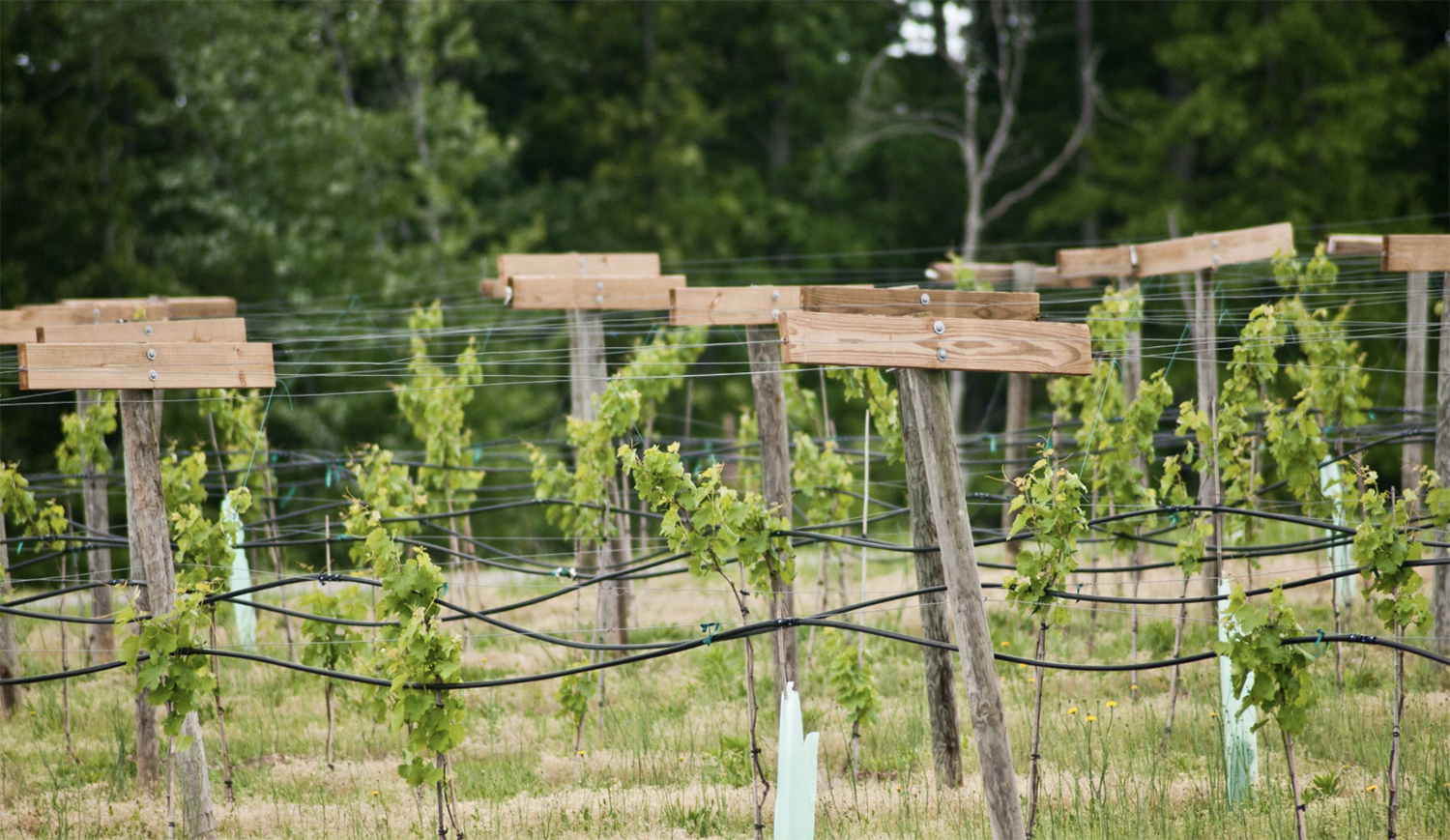
New Website Provides Forestry Resource Repository for Land Managers
January 8, 2025 – The USDA California Climate Hub released a new webpage that compiles datasets and decision-support tools to help land managers and natural resource professionals with assessing the conditions of a landscape for project planning. The list is not exhaustive of all resources but focuses on data and tools available to the public, with an emphasis on resources available within the state of California. The repository also contains a series of factsheets, produced by the USDA California Climate Hub, that offer a succinct overview of the California Wildfire and Forest Resilience Task Force’s Regional Resource Kits and its constituent products.
Task Force Launches New Work Group on Healthy Watersheds
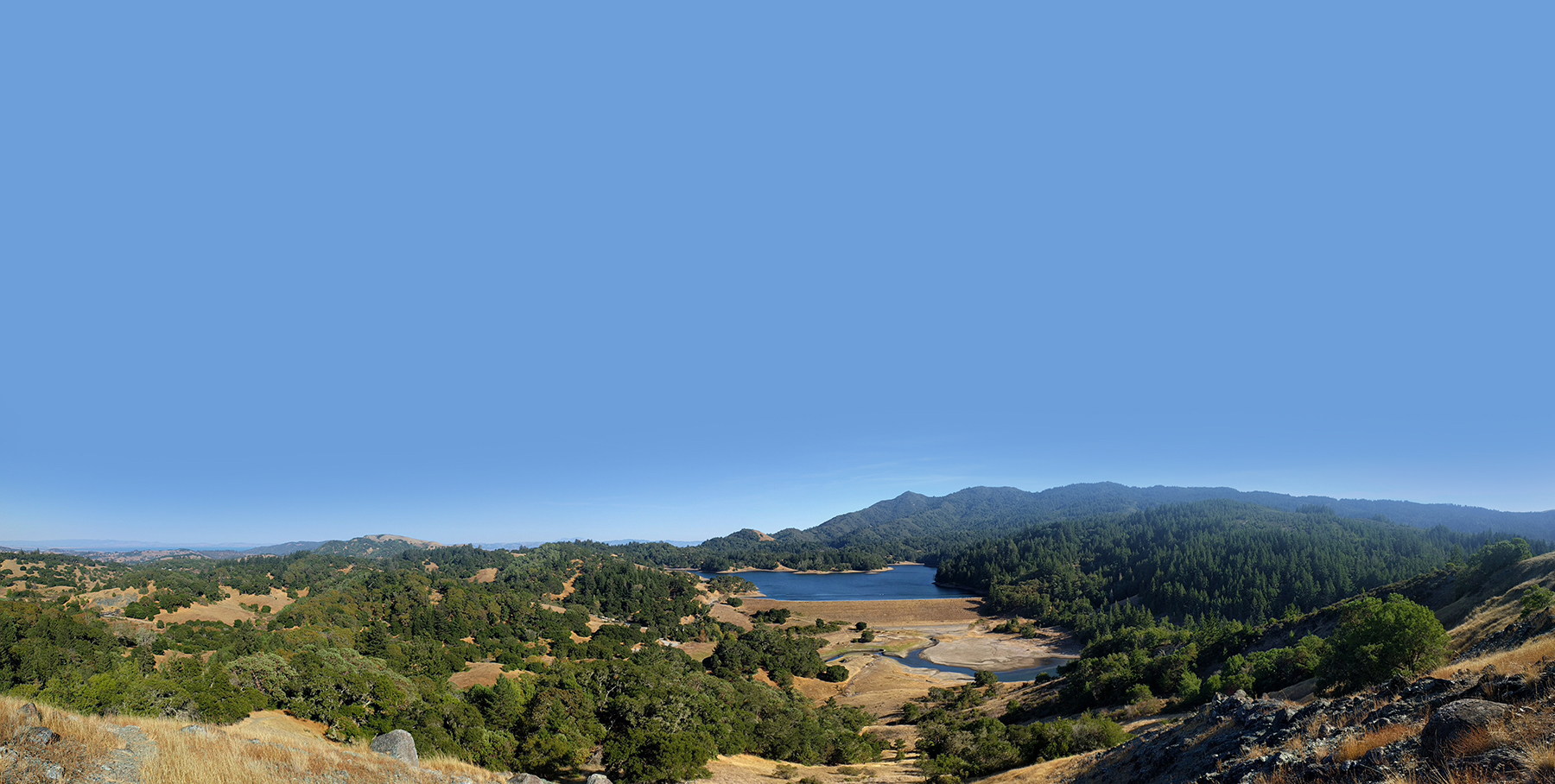
Task Force Launches New Work Group on Healthy Watersheds
August 6, 2024 – The Task Force launched its newest work group which focuses on a critical aspect of the CA Wildfire & Forest Resilience Action Plan – the intersection between watershed health and landscape resilience to wildfire.
It’s well known that wildfires adversely impact watersheds. But it’s important to also recognize that healthy watersheds play a key role in mitigating catastrophic wildfires. The Watershed Work Group promotes fire resilience and watershed health programs that share these important priorities.
Visit the Healthy Watersheds Work Group webpage to learn more about the Work Group partnering organizations and to access a list of programs, plans, and strategies focused on California’s water supply and security.
Forest Service Conducts Fuel Reduction Work in Lake Tahoe Basin

Forest Service Conducts Fuel Reduction Work in Lake Tahoe Basin
The USDA Forest Service Lake Tahoe Basin Management Unit continues cut-to-length mechanical fuels reduction (forest thinning) operations on approximately 275 acres around the Lake Tahoe Basin. This fuels reduction work is part of the NV Energy Resilience Corridors Project that aims to reduce the risk of severe wildfire and create healthier and more resilient forests.


